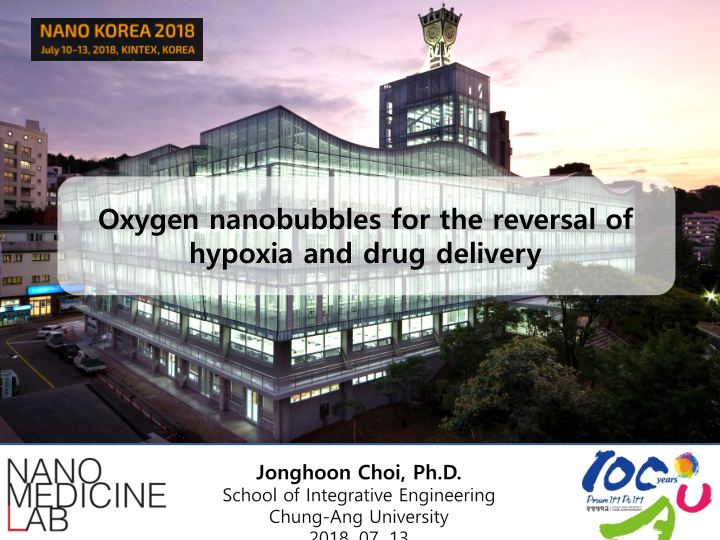



Oxygen nanobubbles for the reversal of hypoxia and drug delivery
THE NANOMEDICINE LAB Ph.D. students (4): Jangsun Hwang, Yonghyun Choi, Saad Khan, Sachin Chavan M.S. students (5): Yejin Kwon, Jaehee Jang, Kyungwoo Lee, Chanhwi Park, Dasom Kim Undergraduate intern (2): Juhye Hong, Nayoung Kim
THE NANOMEDICINE LAB Nanomaterial synthesis • Bio-conjugation of • nanomaterials Biosensor based on • nanomaterials Functional nanomaterials • Drug delivery nanocarriers • Immunologically active • nanomaterials Theragnostic nanomaterials •
Microbubble research in biomolecular imgaing
Oxygen microbubble research Journal of Controlled Release, 2015, 209:139-149. https://carvertubs.com/pure-bubbles/
Why oxygen nanobubbles? • High stability • Controllable surface composition • Carrier for biomolecules & drug molecules • Cell & tissue penetration
1. Hypoxia reverse
Preparation of oxygen nanobubbles
Characterization of oxygen microbubbles Characterization of microsize bubbles. A. Confocal microscopy image of microbubbles, scale bar = 20 µm. B. Fluorescence microscopy image showing microbubbles, scale bar = 20 µm. C. SEM image showing a microbubble, scale bar = 1 µm. D. Size distribution of microbubbles calculated using ImageJ software. E. Concentration of microbubbles calculated in various sample groups taken from the top to the bottom of a 15 mL conical tube.
Characterization of oxygen nanobubbles Size distribution of nanobubbles. A. SEM image of nanobubbles, scale bar = 100 nm. B. TEM image of nanobubbles, scale bar = 100 nm. C. NTA results for particle count and size distribution with mean size distribution in red color. D. DLS results of seven samples of ONBs plotted together to indicate particle size distribution.
Preparation of oxygen nanobubbles Stability, oxygen delivery, and cytotoxicity tests. A. Size distribution using various dilution ratios of ONBs, obtained through an NTA. B. Reduction in bubble count after 30 days of storage. C. Increase in oxygen concentration of deoxygenated water after injection of ONBs and oxygenated DPBS. D. Cytotoxicity of the lipids used in synthesis of nanobubbles; ns means no significance, **** indicates P value < 0.0001. E. Cytotoxicity of ONBs for varying concentrations; * indicates P ˂ 0.05.
Reversal of hypoxia by oxygen nanobubbles
HIF-1a downregulation induced by oxygen nanobubbles HIF- 1α expression assay. A. Comparison of HIF- 1α expression in control and after the reversal of hypoxic conditions. FITC-conjugated anti-HIF- 1α antibodies were used along with DAPI staining of MDA -MB-231 cells. The reduced expression of anti-HIF- 1α is clearly observable in the fluorescence image, indicating successful degradation of HIF - 1α protein due to ONBs. Scale bars = 20 µm. B. HIF- 1α expression evaluated through the indirect ELISA method. The hypoxia control is the untreated sample in hypoxic conditions. Hypoxia bubble means the samples in the hypoxia chamber treated with ONBs. Normal control is an untreated sample in normal conditions. Normal bubble means the samples treated with ONBs in normal conditions; * represents P <0.05, ** represents P <0.01, ns means no significance, n = 3.
Summary Oxygen nanobubbles were prepared and characterized for • their size, surface chemistry and oxygen delivery Lipid surface of bubbles can protect bubbles and also provide • moiety for drug or other biomolecules Delivery of oxygen nanobubbles reverse the hypoxic condition • of cells Delivery of doxorubicin drug molecules with oxygen • nanobubbles provides enhanced drug effects
Acknowledgement Biosystems and Department of Biomedical Department of Department of Biomaterials Engineering Biomedical Organic Chemistry Division Engineering Prof. Assaf A. Gilad Prof. Amnon Bar-Shir Dr. Vytas Reipa Prof. Galit Pelled Prof. Weian Zhao 의공학연구소 Purgo Biologics 뇌과학연구소 School of Medicine 전호정 박사님 분자생명과학과 김홍남 박사님 Prof. Koji Sakai 석현광 단장님 양철수 교수님 최낙원 박사님 Prof. Jun Tazoe 수의과 대학 화공생명공학과 생명공학부 화학공학부 강병재 교수님 구형준 교수님 김교범 교수님 방석호 교수님 JC Bio Inc.
Thank you! Contact Prof. Choi for further information: Email: nanomed@cau.ac.kr
Recommend
More recommend